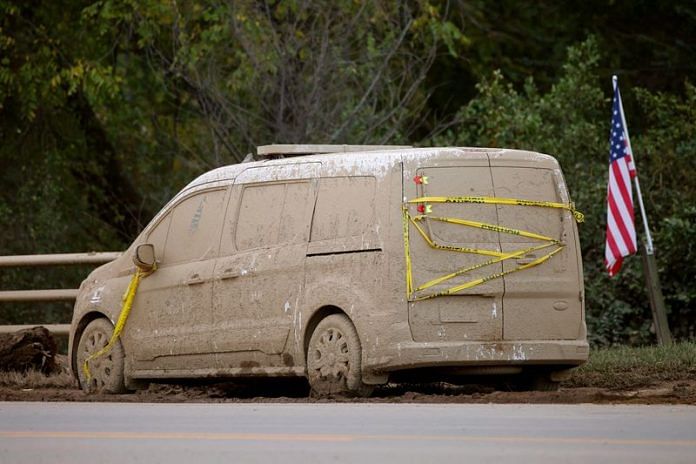By Karl Plume
ASHEVILLE, North Carolina (Reuters) -Tens of thousands of western North Carolina residents remained without running water on Wednesday, six days after Hurricane Helene slammed into Florida and carved a destructive path through much of U.S. Southeast, killing more than 160 people.
The powerful storm inundated the region with catastrophic flooding, destroying pipes, damaging water plants and cutting off power.
As of midday, one-fifth of the 1 million residents in the western half of North Carolina either had no water at all or low system pressure, according to an online state database. Nearly 1.3 million homes and businesses across the Southeast remained without electricity, according to website Poweroutage.us.
Helene came ashore in Florida late on Thursday before turning its fury on much of the Southeast, including Georgia and the Carolinas, as flash floods destroyed homes and ripped victims away from their families.
In hard-hit Asheville, the municipal water supply system, which serves more than 150,000 residents, was badly damaged, leading to low water pressure for some and complete outages for others. Many residents have been warned to expect dry faucets for days or even weeks while pipes are repaired; those with water have been urged to boil it before consuming.
The storm washed out both the main pipes and backup pipes at North Fork, one of three water treatment plants serving the Asheville watershed, according to city and county officials. Another plant, DeBruhl, could not be reached after the storm blocked the access road with debris.
Both the state’s National Guard and the U.S. Army Corps of Engineers are helping to return the plants to normal operations, city officials said. The system’s third main plant, Mills River, is struggling at reduced capacity.
At least 57 people died in Buncombe County, which includes Asheville, according to authorities.
Rachel Simpson, 33, felt lucky to have weathered the storm with only minor damage to her Asheville home.
But she said it has been difficult with no water to bathe, wash clothes or flush toilets. She filled her bathtub the night before the storm, but the water is running low.
“The city says it’ll be at least four weeks before the water comes back on,” she said. “Right now we’re getting by the best we can. All the water we have now we’re getting from friends.”
Water distribution sites have been set up at several locations in and around Asheville. Both the county and the city paid for private supplies of water to be trucked in, and the state and the Federal Emergency Management Agency have since supplied drinking water for distribution around the area.
BIDEN, HARRIS SURVEY DAMAGE
President Joe Biden was visiting North Carolina and South Carolina on Wednesday, including an aerial tour of Asheville.
Vice President Kamala Harris, in the middle of a presidential campaign against Republican former President Donald Trump, travels to Georgia on Wednesday and North Carolina later in the week, two of the hardest-hit states. They also happen to be among seven key battleground states in this year’s election. Trump visited Georgia on Monday.
The water crisis has impeded businesses, hospitals and schools in and around Asheville as locals try to get back to normal.
“The biggest concern for getting students back to school is water,” Asheville City Schools Superintendent Maggie Fehrman said at a press conference on Wednesday. “Without water, we just simply cannot bring students back or staff back into our building.”
People in North Carolina obtain their water from a patchwork of sources, depending on where they live. In major cities, water comes from large water plants, while in remote areas some residents are served by small neighborhood systems or rely on private wells.
Of the roughly 800 community water systems tracked by the state in the area, only half were operating normally.
Water treatment plants across the area are dealing with flooding and power outages, said Josh Kastrinsky, a spokesperson for the state Department of Environmental Quality. In some cases, “pipes that are coming to and from the water treatment plant do not exist anymore,” he said.
“Even if the pipes are there, they’re having trouble getting enough power and system pressure to be able to pump it in the mountains uphill,” he added.
Harrison Fahrer, 37, co-founder of the west Asheville brew house Cellarest Beer Project, knows his problems pale compared to those of people whose houses and businesses didn’t survive. But he’s not sure how he’ll make it without water.
“You turn on the spigot and all it does is hiss,” he said. “If we can’t brew, we can’t pay our bills, our loans, our rent, utilities.”
Fahrer said he knew the storm was coming, but he shrugged it off. Hurricanes don’t hit Asheville, he thought; the storms lose power and just drop some rain.
“No one could have fathomed the storm would be like this,” he said. “It washed so much of the city away.”
Search-and-rescue teams continued to comb through storm wreckage for the missing and to deliver aid amid washed-out roads, smashed bridges and felled power lines.
Some western North Carolina locations may have experienced a 5,000-year event, so perfect were conditions for creating maximum precipitation, said Tennessee state climatologist Andrew Joyner.
A storm before Helene sucked moisture from the Gulf of Mexico and saturated areas like Mount Mitchell, which at 6,684 feet (2,037 meters) is the highest point in the Appalachian Mountains, above hard-hit communities like Swannanoa and Black Mountain. Then Helene approached at the perfect angle to rise over the peak, intensifying rainfall.
“The event was a perfect storm,” Joyner said.
(Reporting by Karl Plume in Asheville, North Carolina; Additional reporting by Bernie Woodall in Asheville, Rich McKay in Atlanta and Jonathan Allen in New York; Writing by Joseph Ax; Editing by Frank McGurty and Jonathan Oatis)
Disclaimer: This report is auto generated from the Reuters news service. ThePrint holds no responsibilty for its content.






